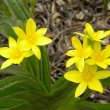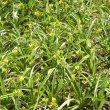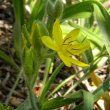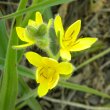Hypoxis hemerocallidea
| Botanical Name | Hypoxis hemerocallidea |
|||||||||||
| Family | Hypoxidaceae - The star lily family. |
|||||||||||
| Pronunciation | hy-POK-sis hem-er-oh-kal-LID-ee-a |
|||||||||||
| Common Name(s) |
English: Star flower; Yellow stars
Afrikaans: Sterblom; Gifbol
IsiXhosa: ilabatheka
IsiZulu: inkomfe
Sesotho: Lotsane; Moli kharatsa
|
|||||||||||
| Plant Group |
|
|||||||||||
| Plant Size |
|
|||||||||||
| Position |
|
|||||||||||
| General Information |
|
|||||||||||
| Specific Information | Hypoxis hemerocallidea arises from a large dark brown corm which is covered with bristly hairs. The corm is bright yellow when freshly cut and has an unpleasant bitter taste.The strap like leaves are up to 400 mm long, arching outwards with the lower surfaces covered densely with hairs. Leaves appear above ground in spring before the flowers.The flowers are short-lived and close at midday. Hypoxis hemerocallidea is fire-tolerant, occurring in grasslands where fires are reasonably frequent. It is dormant during the fire season and the fibres protect the corm against damage. The growth of new leaves is stimulated by the fire, as is the germination of the seeds. Although still widespread in the wild, populations of this plant are declining in high population areas such as Gauteng and KwaZulu-Natal, where it has been heavily harvested during the last 15 years, following the claim that it was South Africa's "miracle muthi" and effective in treating the immune system of HIV sufferers. This claim was later surrounded by controversy. |
|||||||||||
| Ad Break | ||||||||||||
| Flowers | ||||||||||||
| Description | six petaled star |
|||||||||||
| Season |
|
|||||||||||
| Colour |
|
|||||||||||
| Growth Rate |
|
|||||||||||
| Plant Uses |
|
|||||||||||
| Distribution and Habitat | in the Eastern Cape, Free State, KwaZulu-Natal, Mpumalanga, Gauteng and Limpopo, as well as Botswana, Lesotho and Swaziland, on sandy hills on the margins of dune forests, in open, rocky grassland, on dry, stony, grassy slopes, and on mountain slopes and plateaus |
|||||||||||
| Planting Suggestions | Hypoxis grows well in full sun in well-drained soil. As the corms will remain in place for some time, enrich the soil with a dose of compost or mulch a couple of times a year. The bulbs lose their leaves in autumn and are dormant in winter when they need to be kept dry. The leaves re-appear in late winter. |
|||||||||||
| Medicinal Uses | Hypoxis hemerocallidea has been used as a traditional medicine for centuries and is possibly the best known muti plant in the country. Weak infusions and decoctions of the rootstock are used as a tonic during convalescence, to build up the immune system of patients suffering from cancer, tuberculosis and HIV, for urinary tract infections, testicular tumors, as a laxative, to expel intestinal worms, for anxiety, palpitations, depression and rheumatoid arthritis. Commercial products are now widely available. NOTE: Hypoxis contain toxic substances in the raw form, and must be used with caution and under the care of a trained herbalist. |
|||||||||||
| Ad Break | ||||||||||||









Comments
african potato plant-availability
Good day
Please can you tell me where I might purchase this plant?
I live in hennenman, free state and we get sometimes severe frost...is this a problem?
Thank you so much
African potato
According to my sources, this plant can cope with freezing weather as it loses its leaves in autumn and remains safely under the ground until spring. I do have stock of these bulbs for sale. Please contact me on the contact form for further information.
Info about bulbs for sale
Hi Lorraine, I'm an anthropologist-researcher and I try to cultivate Hypoxis here (Alban Hills near Rome, Italy) andI need seeds or similar for my personal experiment an this field. Can You contact me trought e-mail (starmiles@gmail.com)? I'm very glad to meet you in this virtual but for real place.
Massimo Migliastro
purchase
Hi, im doing a research project. do you perhaps know where the extracts or healing creams made from hypoxis can be purchased?
Hypoxis products
Hi Erin
I am afraid I don't. I know there is one company in South Africa that selles creams but most suppliers are overseas. Try Googling 'buy Hypoxis extracts cream South Africa'.
Kind regards
Lorraine
Discuss this plant
Share knowledge, ask a question or give an experience.